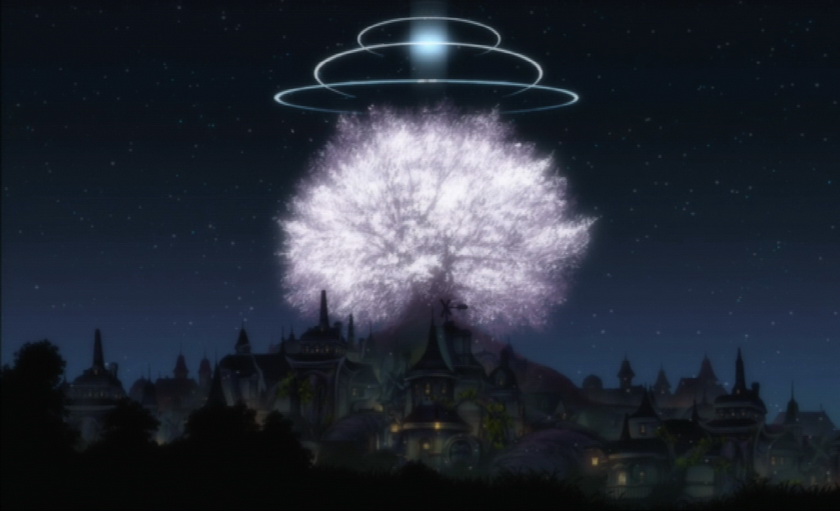Don’t let its anime looks fool you. Namco Bandai’s Tales of Vesperia, exclusively for Xbox 360, has a story as deep and morally ambiguous as any WRPG this console cycle, along with one of the best battle engines ever made for a RPG.
In Terca Lumereis, the world of Tales of Vesperia, society is governed by a series of checks and balances between individual autonomy and rugged individualism versus the rule of law and social interdependency. The latter is typified by the Empire and its capital city, Zaphias, which represent the political and military aspects of humanity. Imperial society is orderly, safe, and rigidly stratified, and every individual, rich or poor, clearly knows their place. On the other end of the spectrum are the Guilds, loosely united under the leadership of Don Whitehorse in the city of Dahngrest, where survival of the fittest and a vigilante approach to law and order are the tradeoffs for greater individual freedom. However, the Empire is currently without a head, and forces are afoot that could disrupt the tenuous balance of power some 20 years after a terrible war between humans and magical beasts known as Entelexeia.
The most valuable resources in Terca Lumereis, and the ones which therefore cause most of the conflict in the world, are magical stones known as blastia, which are the crystalized remains of dead Entelexeia. With formulas engraved into them by specially trained mages, blastia serve a large variety of vital functions – water supply, food production, energy to power industrial processes, military power, and magical barriers to keep the human population in the cities safe from being overrun by the hordes of vicious monsters that roam freely in the wilderness.
Yuri Lowell, the hero of Tales of Vesperia, is a resident of the Lower Quarters of Zaphias, home of the vast peasant population whose labors support the privileged elite of the Empire, yet whose needs are often marginalized by those in power. Growing up in abject poverty with his best friend Flynn Schifo, Yuri and Flynn both enlisted in the Imperial Army, hoping to bring the problems of the Lower Quarters to the attention of the Imperial government. However, Yuri and Flynn experienced very different outcomes from their time in the Imperial army.
Flynn, a steadfast believer in the rule of law, rose steadily through the ranks of the Army, hoping to effect gradual, orderly change in the social stratification of the Empire through consensus and eventually becoming a respected commander of the Imperial Knights. Yuri, disillusioned with the abuses of the peasantry he witnessed at the hands of the upper classes, resigned from the army. He now lives as a sort of Robin Hood figure in the Lower Quarters, constantly in trouble with Imperial authorities. Even though they still care about each other like brothers, Yuri’s rebelliousness clashes with Flynn’s dedication to working within the law, and the conflict between the two drives much of TOV’s main story.
One day, the blastia that provides the Lower Quarters with clean water is reportedly stolen by a mage of the Imperial court, flooding the Lower Quarters with polluted water. Angered by the Imperial government’s indifference to the plight of the Lower Quarters, Yuri infiltrates the palace looking for the thief. He encounters a young noblewoman who is looking for Flynn and is on the run from the Imperial authorities, and escapes from the palace with her. It turns out that the woman is none other than Princess Estellise (“Estelle”), one of the two candidates for succession to the long-vacant Imperial throne! Estelle has miraculous healing powers, independent of blastia, but these powers also cause her to become very ill when she uses them.

At this point, Yuri, under pursuit by Flynn and now facing the death penalty for kidnapping the princess, abandons the Empire completely, seeking the greater freedom of the Guilds. Together with Estelle and a young monster hunter named Karol, he founds a new guild devoted to fighting for justice called Brave Vesperia, named after a mythological hero, bringing together the usual ragtag collection of heroes. Karol is something of an outcast among the guilds due to being inept as a monster hunter, but he becomes much stronger under Yuri’s influence. Rita, the mage wrongfully accused of sabotaging and stealing the water blastia, is a researcher who very nearly has a fetish for blastia, and a violent tsundere disposition that she generally takes out on Karol. Raven, a mysterious, seedy man, forces his way into the party, seemingly working as a double agent for both the Empire and the Guilds. Judith is an elven warrior with a happy-go-lucky disposition who is inexplicably on a mission to destroy blastia cores. Last but not least is Yuri’s steadfast companion, Repede – a very large dog who could easily pass for a wolf and smokes a pipe. From time to time, ToV will offer you the Tales series’ signature “skits,” which are brief, often humorous conversations between your party members, designed more to flesh out the characters rather than provide clues for the player. All of the skits have full voice acting and are optional.
Brave Vesperia, having pledged to protect Estelle, eventually finds itself embroiled in conflicts which threaten to tear the world apart. The Entelexeia have marked Estelle for death, calling her a “Child of the Full Moon” because her healing powers are supposedly causing major disruptions in the world’s magical energy, possibly causing a terrible cataclysm. Alexei, the Commandant of the Imperial Knights, seeks to eliminate Estelle and the other heir to the Imperial throne, Prince Ioder, and install himself as Emperor, using the power of blastia-enhanced zombie soldiers to engage in a purge of the “scum” of the world. Duke, a mysterious man, seems to be neither friend nor foe, at times aiding Yuri and his friends against Alexei and at other times opposing Brave Vesperia.
In its own way, Tales of Vesperia explores the gray areas of human morality as deeply as any Bioware RPG. Each of the game’s villains is portrayed as very human, with their seemingly evil acts being guided by good intentions. Alexei joined the Imperial Army with the intentions of fighting for justice for the people, much as Yuri and Flynn did, but when he saw his efforts bearing no fruit and injustices continuing unabated, he decided to purge the world of its “scum.” Duke, having seen his best friend, the Entelexeia Elucifer, fall in battle in what he saw as a needless war brought on by humanity’s refusal to make peace with the Entelexeia and their desire to exploit the spirits of the Entelexeia as blastia, decides to sacrifice humanity in order to save the world and the Entelexeia. The actions of both of these men make a deep impression upon Yuri, who sees traces of himself in both Duke and Alexei. Yuri and Flynn are no less complex. After he sees two Imperial officials he witnessed committing terrible crimes released and pardoned by the Empire, Yuri decides to take justice into his own hands. Flynn points out to Yuri that he is now guilty of murder, but Flynn is also troubled by what he sees as a failure of the justice system he has dedicated his life to, and he cannot bring himself to arrest Yuri.

Illustrated by Kosuke Fujishima (Ah! My Goddess, Sakura Wars, Tales of Symphonia), Tales of Vesperia uses an anime cel-shaded look. Though the characters lack the detail and expressiveness of Valkyria Chronicles on PS3, Tales of Vesperia is nevertheless very clean and crisply animated. The game’s world is colorful and richly detailed, from dark dungeons to vast, sprawling cities. The monsters are quite eclectic and freakish, which is always a plus, and unlike some other RPGs, they’re generally appropriate in context to the areas they appear in. This is one of the best-looking RPGs yet.
Tales of Vesperia’s soundtrack was composed by Motoi Sakuraba, the main Tales series composer, and Hibiki Aoyama. It follows the same general style as other games, a fusion of rock, classical styles, electronic music, and J-pop, and the village, over-world, and battle themes sound similar to those in other games of the series. However, it does not have any tracks which match the quality and grandeur of some of the best tracks from Tales of Symphonia, and is overall weaker than its Gamecube predecessor in this regard. Its voice acting, provided by a number of staples of the American anime industry, including Megan Hollingshead, Michelle Ruff, and Troy Baker as the voice of Yuri, is very well-done, with JRPGs in general making steady improvements in English voice acting. The game’s theme song is “Ring A Bell” by Bonnie Pink, a J-pop singer who records most of her songs, including this one, in English.
Tales of Vesperia features the best iteration yet of the signature Tales battle system. Unlike the turn-based menu-driven systems typically employed by JRPGs, the Tales series uses an action-based battle system. In ToV, characters move, attack, and dodge in real time in 3-D space. You can only control one character at a time directly in battle, although you can pause the battle to issue commands to party members if you wish. You can set the strategies of AI characters within battle and in the game’s main menu. Spells have casting times generally dependent on how powerful the spell is, with the spell being interrupted if the caster gets knocked down. Both spells and items also have cool-down periods. By combining basic and special attacks, you can unleash increasingly powerful Artes. Standard for Tales games, the battles tend to be frenetic and chaotic, and if you are not careful, even regular enemies can overwhelm your party. Boss battles can be difficult to the point of frustrating, and unfortunately, your party’s AI contributes to this frustration at times, with healers inexplicably throwing themselves into the thick of battle unless you set strategies for them to avoid battle. As with many other JRPGs, your party builds up a “limit break” meter which when full and activated, increases your party’s power by either allowing them to freely attack enemies with no cool-down period (allowing you to hit the enemy almost at will) to unlocking the game’s ultimate attacks, Mystic Artes. Despite the occasional hiccups in your party’s AI, ToV is one of the most satisfying RPGs in terms of combat. Most of the boss battles in the game have Xbox Live achievements associated with them, unlock-able by fulfilling certain conditions or performing certain actions in battles. All of these achievements are “Secret Missions”, meaning you won’t know them until you do them, or until you read about them in a strategy guide or online FAQ.
[tube]jXMw378u89g[/tube]
There haven’t been a lot of JRPGs released on consoles this generation, and if you’re looking for a good JRPG, Tales of Vesperia deserves a place in your library. If you’re interested in JRPGs but turned off by the menu-driven combat most of them feature, it’s also worth it for you to give ToV a try. Tales of Vesperia can be found for less than $20 new on Amazon, and at 50 hours will give you a great deal of value at that price.



This review is amazing! Keep up the great work! I always look forward to a new review by you being published.